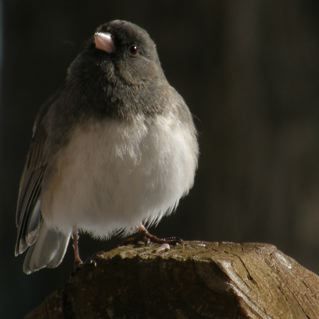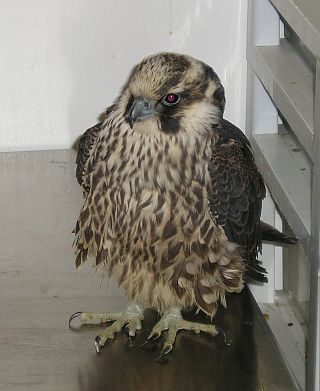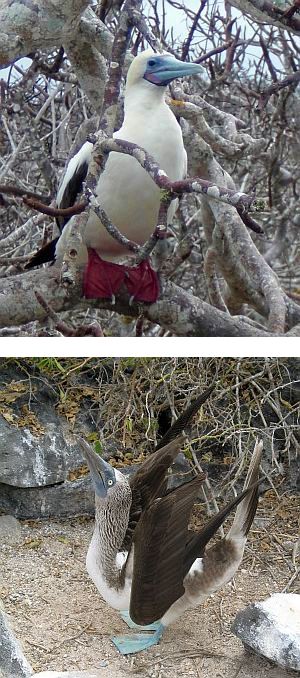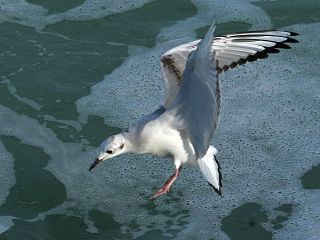 A few weeks ago I was interviewed as part of The Allegheny Front’s Environmental Oral History Project. Tonight, 12 November 2008, that interview will air on WYEP 91.3 FM between 7:00pm and 7:30pm. In it, I talk about birds, nature and how they inspire me.
A few weeks ago I was interviewed as part of The Allegheny Front’s Environmental Oral History Project. Tonight, 12 November 2008, that interview will air on WYEP 91.3 FM between 7:00pm and 7:30pm. In it, I talk about birds, nature and how they inspire me.
Monthly Archives: November 2008
Cold Wind At Dawn
 The one good thing about winter is that it’s easy for me to be up before the sun. Despite the cold I sit on my front porch and watch the sky, waiting for the birds to wake up.
The one good thing about winter is that it’s easy for me to be up before the sun. Despite the cold I sit on my front porch and watch the sky, waiting for the birds to wake up.
It is still dark. The wind is cold. The weather has changed.
Silhouetted against the clouds a lone mourning dove shoots for the sky and suddenly dives for cover. He’s seen a coopers hawk perched above, invisible to me in the half light. The coopers hawk tries for the dove, misses, and flies away. The idea of a dove for breakfast roused him earlier than he’d planned.
A moment of silence and then I hear a distant caw. The first flock of crows has left the roost. Over a hundred crows in this initial push, flying close together, doubling back on themselves, making a circle above my house. The wind complicates their progress and keeps them focused and silent. For the next twenty minutes flocks of crows pulse by, a hundred at a time.
The sky brightens a little and high above the crows loose flocks of robins fly south. I wonder if they’re migrating today or merely going out to forage and return.
Now the dark-eyed juncoes begin to twitter from the hedges while squadrons of starlings pass overhead. More birds call from the underbrush – cardinals and song sparrows. There are so many birds on the move that I can no longer count them, though the sun hasn’t risen yet.
Then exactly at dawn a single house sparrow in my neighbor’s spruce says “cheep.” Soon the entire flock is chattering inside the tree, conducting a long conversation to greet and plan the day.
The cold has penetrated my coat. I’ve finished my coffee. If I wait any longer I’ll be stiff from cold. Time to go indoors and start my day, too.
(stock photo from Shutterstock)
Snowbirds
 Though a few dark-eyed juncos have been in Pittsburgh since late October, the flocks showed up in force last weekend. When they arrive I always think of this poem by William Stafford.
Though a few dark-eyed juncos have been in Pittsburgh since late October, the flocks showed up in force last weekend. When they arrive I always think of this poem by William Stafford.
During the breeding season juncos prefer colder climates. They breed in Canada and New England into northern Pennsylvania and the Appalachian mountains. Habitat is everything. That’s why they’re found on Laurel Mountain in the summer.
Interestingly, eastern Massachusetts doesn’t have the right habitat for them to breed. So it’s from my Boston friends that I learned juncos are called “snowbirds” because they arrive with the first snow.
Juncos aren’t the only snowbirds on the move. Chuck and Joan Tague left town last weekend to spend the winter in Florida. Chuck supplies most of the photos on my blog, so I’m hoping my stay-at-home friends will supply me with a few pictures of Pennsylvania’s winter birds. Thus, this photo is by…
(photo by Marcy Cunkelman)
Bird Blog is one year old!
 Outside My Window is one year old today!
Outside My Window is one year old today!
Little did I know when I started this blog how far it would come and how many people I’d meet.
A year ago blogging was all new to me. I didn’t know the mechanics of WordPress (the software that displays this blog), I desperately needed photos to illustrate each entry, and I had a low level dread of running out of things to write about. Added to that was the fear that no one would read it and my efforts would be pointless.
Those worries quickly disappeared. Chuck Tague, and many new friends, supply me with beautiful photos. I seldom run short of subject matter and the blog has been fun to write especially when I have to do research. I’ve learned more about birds and hope you have too.
There have been ups and downs along the way, the happiness of baby birds and the sadness of a young peregrine’s death, the exciting blogs and the boring ones. I’ve even received a little bit of unexpected fame.
But the best part has been meeting you, my readers. I am amazed and pleased at how many of you there are. You’ve helped me with questions, suggestions, photos and – thankfully – corrections.
So this celebration is really about you. I’d love to meet more of you. Leave a comment below and let me know which blogs were your favorites. Have I missed a topic you’d like me to explore? Do you have a photo or a question?
And please do tell me where you’re from. I would love to know how far this blog reaches. Does it go around the world? Only you can tell.
(Thanks to Joan Guerin for the birthday cake. Click on the cupcake and wait a few seconds to see a surprise.)
bird-thday
Arctic Peregrine Makes Unplanned Stop in Pittsburgh

6 November 2008
John Moore had a surprise last month at the construction site where he works on Fort Duquesne Boulevard downtown. There on the balcony, apparently trapped, was a juvenile peregrine falcon. He immediately called the National Aviary and the PA Game Commission.
Todd Katzner arrived from the Aviary and captured the bird. The peregrine was unbanded so he knew at a glance it was not one of those born in Pittsburgh.
The bird’s plumage gave the nod to its origins. This peregrine was born in the arctic, probably Canada, and was traveling to the tropics and beyond on his first migration. He had become trapped on the construction site and was undernourished and dehydrated.
The National Aviary does not rehabilitate birds so, coordinating with Wildlife Conservation Officer Beth Fife, Todd took the peregrine to the Animal Rescue League Wildlife Center in Verona where it was fed and rehydrated.
Time is of the essence. This peregrine has far to go to complete his migration and he needs food along the way. He arrived here with the push of migratory birds (his food source) and he needs to resume his journey while there’s still enough to hunt on the wing. His destination is South America, a journey as long as Elizabetha’s. He can’t afford to linger in Pittsburgh.
Fortunately, after two weeks of rehabilitation, Jill Argall of the Wildlife Center deemed that this peregrine is in good condition and ready to leave. He was released this morning at 9:30AM.
Good luck to him. We wish him well in this, his first and hardest year of life.
p.s.: See the video of his release at http://www.post-gazette.com/multimedia/?videoID=101161
(photo by Dr. Todd Katzner of the National Aviary)
One foot, Two foot, Red foot, Blue foot
 Dr. Seuss was talking about fish but when I received these two photos from Deb Acklin this title immediately came to mind.
Dr. Seuss was talking about fish but when I received these two photos from Deb Acklin this title immediately came to mind.
Here are two unusual characters you’re never going to see at home. Deb saw them at the Galapagos Islands last month.
Meet the red-footed booby and the blue-footed booby.
No lie! These birds are called boobies from the Spanish word for dunce because they’re very clumsy on land. Their fancy feet aren’t made for walking, they’re made for impressing the opposite sex. Same idea as stiletto heels.
The two species have different nesting habits (red-footed boobies nest in trees, blue-footed on the ground) but they have similar courtship displays in which their feet play a part.
During courtship the males of both species point their bills and tails at the sky, raise their wings and, most importantly, display their feet. The blue-footed booby even does a dance in which he lifts and stamps each foot to show it off.
All this is to impress the ladies who are flying by in hopes one of them will stop and get to know him. If she does, the pair will put their feet to another use – incubating the eggs. Boobies don’t have a brood patch so they use their feet, just like their relatives the northern gannets.
Interestingly, female blue-footed boobies have bluer feet than the males. Click on the picture to see how blue they can get!
The boobies’ courtship efforts are successful at the Galapagos but their nesting success depends on the food supply – fish – and the food supply is governed by ocean temperature. During an El Niño event, the ocean heats up and the fish go elsewhere. This spells trouble for the boobies. Their chicks starve, with as much as 70% nest failure for red-footed boobies who lay only one egg per year. Even if the chicks survive, during an El Niño they grow so slowly that it takes a year to mature.
Sadly, red-footed boobies face another threat. Unlike blue-footeds whose largest breeding population is on the Galapagos, red-footed boobies breed on many Pacific islands. In some places they are in decline because the islanders eat them.
Fortunately the Galapagos has protection programs to keep the birds safe. I hope to go there some day and see these fancy feet for myself.
(photos taken at the Galapagos Islands by Deborah Acklin)
Bonnies
 Fall migration is bringing gulls to southwestern Pennsylvania. Yesterday at Moraine State Park their numbers were up considerably compared to my last visit in late September.
Fall migration is bringing gulls to southwestern Pennsylvania. Yesterday at Moraine State Park their numbers were up considerably compared to my last visit in late September.
Though most people call them “sea” gulls, those who visit Pittsburgh breed in interior Canada and Alaska and spend the winter in similar habitat further south. Species who breed at the ocean don’t tend to come here as there’s no point in crossing the mountains. Gulls, however, are great for making exceptions to every rule – so don’t quote me.
There’s one gull who makes a radical habitat change from summer to winter, from nesting in trees in the taiga to wintering at the ocean. We don’t see many of them here but it’s my favorite gull, the Bonaparte’s gull, named for Philadelphia ornithologist Charles Lucien Bonaparte in the early 1800s.
Bonaparte’s are smaller than most gulls, have bright white primaries (the long feathers at the end of the wings) and are easy to identify by their floating, mothlike flight.
That said, gulls are notoriously difficult to identify. They go through many plumages as they mature so if you’re an expert – which I am not – you can tell the species, the time of year, and the age of the gull by looking at its feathers.
I usually can’t do that but the Bonaparte’s gull in Chuck Tague’s picture is holding still so I can tell you it’s in its first winter. That’s because he has black lines on the outer edge of his wings and a black line across his shoulder that looks like an ‘M’ when he flies. Adult Bonaparte’s have crisp all-white primaries above and below and no black shoulder line.
I would love to see more Bonaparte’s gulls – and more often – but they aren’t going to stay. They’re headed for the Atlantic. As Chuck says, “My Bonnie lies over the ocean.”
(photo by Chuck Tague)